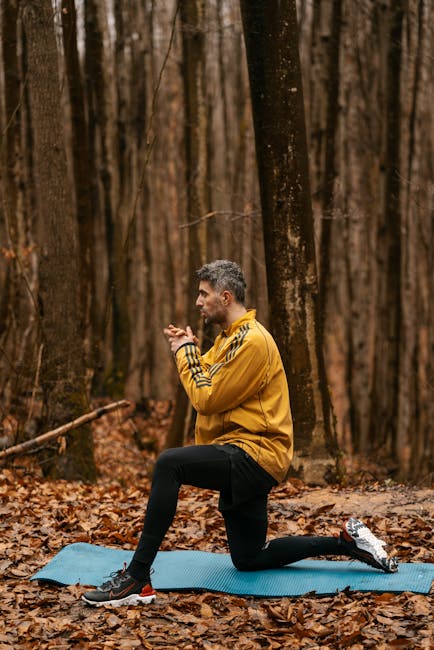Feeling as flexible as a rubber band sounds fun, but being as inflexible as a stick is definitely not. Whether it’s trying to tie your own shoelaces or reaching the overhead compartments in a plane, having a limited range of motion can be pretty frustrating. But what’s worse? Suffering an injury because you skipped your stretching routine. Yep, just when you thought you couldn’t have more problems. So, let’s talk about flexibility, stretching, and how to avoid falling apart like a cheap toy. Get ready to limber up (and maybe chuckle a bit) as we dive into “Maximizing Flexibility: Stretching for Injury Prevention.
Contents
- 1 Introduction: Understanding the Importance of Stretching to Prevent Injuries
- 2 The Science behind Stretching: How Flexibility Enhances Physical Performance
- 3 Effective Stretching Techniques for Various Body Parts: From Hamstrings to Shoulders
- 4 Incorporating Stretching into Your Fitness Routine: Tips and Tricks for Maximum Results
- 5 Conclusion: The Key Role of Stretching in Maintaining Overall Health and Well-being
- 6 Don’t be a Stiff! Keep Stretching and Stay Safe
Introduction: Understanding the Importance of Stretching to Prevent Injuries
When it comes to sports and physical activities, injuries are an ever-present threat. It’s like playing a game of Jenga with your muscles and bones – one wrong move and everything comes crashing down. But fear not, for there is a secret weapon in your arsenal against injuries: stretching!
I know, I know. Stretching can be boring and tedious. It’s like the broccoli of exercise – you know it’s good for you, but you’d rather have a juicy steak instead. But think of it this way: stretching is like the warm-up before a show. You wouldn’t want to start a concert with a cold voice, would you? Same goes for your body – you need to warm up your muscles before putting them to the test.
Moreover, stretching doesn’t just prevent injuries, it can also enhance your performance. Think of your muscles as rubber bands – the more you stretch them, the more elastic they become. This can improve your range of motion, flexibility, and overall physical ability. So, don’t skimp on the stretches, folks! Your body will thank you for it later.
Your stretching routine should include:
• Dynamic stretching – this involves movement to activate your muscles and get your blood flowing
• Static stretching – this involves holding a position for a certain amount of time to increase your flexibility
• Foam rolling – this involves using a foam roller to massage your muscles and release any tightness
Remember to always listen to your body and avoid overstretching, as this can lead to injury. And if you need further motivation, just imagine yourself walking like a penguin for a week because of a pulled muscle. Trust me, it’s not a good look.
The Science behind Stretching: How Flexibility Enhances Physical Performance
Would you rather stretch your muscles or stretch your imagination? Just kidding, you can do both. Is stretching important? Absolutely. Does it work like magic? Nope. So, what does science say? Here are some interesting nuggets on the science behind stretching:
1. Stretching enhances flexibility, which increases our range of motion (ROM). An increased ROM improves our physical performance by reducing the risk of injuries, increasing our endurance, and enabling us to take on daunting challenges. It also allows us to do more complex and intricate movements, like the dance moves Beyoncé pulls off flawlessly (no, seriously, how does she do that?)
2. When we stretch, we engage our muscles, and the increased blood flow helps them recover faster from physical exertion. It also decreases the build-up of lactic acid which delays fatigue, which means we can keep going, and going, and going, like the Energizer bunny (with less drumming).
3. Stretching affects our mental health, too. Ever feel a soothing calm after a yoga class? That’s because stretching releases endorphins, the feel-good hormone, that reduces stress and anxiety. It’s like getting a bear hug from a fluffy golden retriever, only less slobbery and more socially acceptable.
So, next time you’re tempted to skip a pre-workout stretch or rush through a post-workout one, remember that you’re not just limbering up your body, you’re enhancing your physical performance and mental wellbeing. And if that’s not enough motivation, think of all the awesome dance moves you’ll be able to show off.
Effective Stretching Techniques for Various Body Parts: From Hamstrings to Shoulders
When it comes to stretching, it’s all about finding the right techniques for the specific body part. Here are some effective and humorous ways to stretch your hamstrings, hips, and shoulders.
Hamstrings: Imagine you’re a cat laying down and reaching out with one paw to grab a toy mouse. Now, stretch your body forward, bringing your face closer to your toes. Hold for 30 seconds and repeat with the other “paw”. If you’re feeling adventurous, try it with both “paws” at once. Meow!
Hips: Pretend you’re a quarterback getting ready to throw a pass. Take a wide stance and shift your weight onto your back leg. Now, rotate your hips as if you’re winding up to throw the ball. Hold for 30 seconds, then switch sides. Bonus points if you hum the Monday Night Football intro.
Shoulders: Stand with your feet shoulder-width apart and raise your right hand straight up in the air. Extend your pointer finger and twirl it around in a circle. Keep going, faster and faster, until your arm starts to ache. Congratulations, you just did the world’s most effective shoulder stretch! Repeat with the left hand.
So, there you have it, folks. Effective stretching techniques for hamstrings, hips, and shoulders that are sure to make you laugh and stretch at the same time. Don’t forget to breathe and have fun with it!
Incorporating Stretching into Your Fitness Routine: Tips and Tricks for Maximum Results
Stretching is an often overlooked aspect of any fitness routine, but incorporating it can do wonders for your body. Whether you’re a seasoned gym-goer or new to the game, there are a few tips and tricks that can help you get the most out of your stretching sessions.
First, start with a dynamic warm-up. Before jumping into any stretching, it’s important to get your blood flowing and your muscles warmed up. Incorporate some light cardio or dynamic stretches, like walking lunges or high knees, to get your heart rate up and your joints moving.
Next, incorporate some static stretches. These are the familiar stretches that involve holding a position for a certain period of time. Make sure to stretch all major muscle groups, like your hamstrings, quads, and calves. Hold each stretch for at least 30 seconds, and don’t bounce or force yourself into any position. Remember, stretching should feel good, not painful!
Finally, don’t be afraid to get creative with your stretching. Try incorporating yoga poses, like downward-facing dog or pigeon pose, into your routine. You can also use props like foam rollers or resistance bands to enhance your stretching. And remember, stretching doesn’t have to be boring – put on some music or stretch with a buddy to make it more fun and enjoyable. Trust us, your body will thank you for it!
Conclusion: The Key Role of Stretching in Maintaining Overall Health and Well-being
Stretching is not just for the gym rats or fitness enthusiasts, it can be your secret weapon in maintaining overall health and well-being. Here are some reasons why stretching can make a difference in your life:
- Stretching increases flexibility, which can help prevent injuries and improve posture.
- Stretching increases blood flow to your muscles, which can reduce muscle soreness and facilitate muscle recovery after a workout.
- Stretching can reduce stress and tension in your body, which can improve your mood and help you sleep better.
In addition to these benefits, stretching can also be a great way to relieve boredom or take a break from a long workday. So, the next time you’re feeling sluggish or in need of a mental break, try some simple stretches. You might be surprised at how refreshed and energized you feel afterward.
In conclusion, stretching is not just a physical activity, it’s a mental and emotional one too. It’s a way to connect with your body and improve your health and well-being in a holistic way. So, whether you’re a seasoned yogi or a casual stretcher, keep making time for this important practice. Your body (and mind) will thank you.
Don’t be a Stiff! Keep Stretching and Stay Safe
And that’s a wrap, folks! Now that you’ve learned how beneficial stretching can be for preventing injuries, don’t be a stiff about incorporating it into your daily routine. Remember, your body is your temple, and it deserves all the TLC you can give it. So go ahead and touch your toes, kneel down to say a prayer, or even attempt the splits (if you’re feeling brave). As long as you’re keeping your muscles flexible and injury-free, you’ll be able to live a full and active life. Plus, who doesn’t want to show off some killer dance moves at a party or impress their yoga instructor with their flexibility? So, let’s all raise a glass to stretching and staying flexible, because life is too short to be a stiff!








Leave A Comment